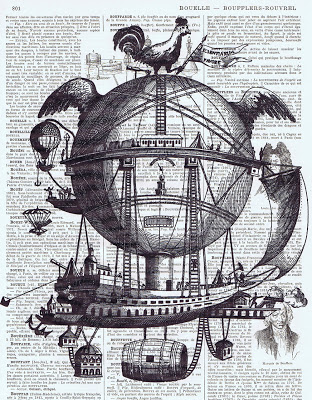
The Hot Air Balloon

The machine has been shipped from London and inflated overnight in the scrub a few steps from the former site of the scaffold, whose remnants have been scrupulously removed. Beneath the swaying gas envelope an observation car is stamped with the words: MARS CONCESSION. The Khedive is delighted; he's said to take a keen interest in modern technology, examples of which, including telephones and flush toilets, are installed throughout his palace, according to amused visitors from the English colony. He briskly questions the pilot, a dark, taciturn junior officer in the Royal Navy who has served aboard the Khedive's Suez yacht, the Mahroussa ... Sir Harry hardly seems to have benefitted from having passed the night in the guest house that was constructed for his use and furnished with a featherbed and brass lavatory fittings. Through fatigue-rimmed eyes he looks at the ascension balloon with disgust, as if it's yet another device designed primarily for his discomfort. Ballard asks if he would prefer to remain in camp."No, I'll do it," he says through gritted teeth.
The balloon's shadow dances among the dunes. Some inexplicably idle fellahin observe the party from a distance, their expressions passive, as if Montgolfiers are common desert flora. The pilot welcomes the Khedive, Sir Harry, Ballard, Thayer, and Miss Keaton onto the gondola, which hovers inches off the ground, its ballast bags loaded with sand-imported from Britain with the gondola. The vehicle rocks as it takes on the passengers' weight. Ballard briefly reflects, before an ascent hardly as dependable as a lift's, that it carries the four men essential to the Equilateral and the millions of pounds sterling that have been invested in it. Gripping the gondola's railing, the Aeronauts wave to the onlookers, a small party of Europeans and the Khedive's entire entourage, including the military band, which performs "God Save the Queen" and the Egyptian national anthem, composed by Verdi.
The land they've been excavating suddenly drops away, accompanied by applause and harrahs. Point A is far below at once.
As the sun-bleached tents and mud-brick structures of the settlement recede, Thayer murmurs surprise. In his carriage with Bint a few weeks ago, he thought he was circumnavigating a burgeoning metropolis. But very quickly now Point A is seen to be a modest desert outpost, a few hundred yards square, a cluster of tents and buildings, of which only the hammam and the pitch factory, may be recognized.
Then the two sides of the triangle radiating from Point A come into view, diverging toward points beyond the horizon three hundred miles apart, two black, throbbing lines laid into the sand, just as foreseen in Thayer's letter to Philosophical Transactions in 1883, just as Ballard surveyed them in 1891 and '92. They cut through whatever dunes or hillocks they encounter. Their blackness imprints itself on Thayer's retinas. No one can doubt from this height or from any other that these are the artifacts of a sensitive, calculating intelligence. The balloon rises and the Equilateral continues to reveal itself.
The music from the Khedive's military band reaches them, with some of the instruments muted in the breeze and others amplified, producing exactly the sort of heavenly cry we may expect in the atmosphere's upper strata.
Exhilaration courses through Thayer's veins. He's impressed with even more force than he was at the pitch factory, when he saw little more than Vertex BAC, or when he stood on the ridge above Side AC. His eyes are wide, his mouth half open. All these years of hard labor are laid out before him on the alabaster plain as if on his own drafting table.
Without saying a word, Thayer takes Miss Keaton's warm right hand and squeezes it hard. For the next several minutes the secretary is unable to see the Equilateral, or the desert at all, or to hear the winds whistling through the lines that attach the gondola to the balloon. He releases his grip. When her vision clears and she can inspect the Equilateral below, she doesn't think of looking for the foreshortening of the triangle's upper portions in the far distance.
"My Lord Jesus."
At first Thayer believes it's Ballard who's whispered this gentle oath, but no, it's Sir Harry.
The few minutes aloft have wrought a transformation. Color has returned to his face. His mouth's twisted into an unguarded grin that's nearly boyish.
"My Lord Jesus," he repeats. "Look what we've brought off! This is the greatest mark of man's hand upon the Earth. Ballard, you've earned your place in history. Professor Thayer ---" he begins, and then simply embraces him, almost overcome.
The Khedive is visibly moved as well, making lip-smacking noises and inward sighs. He lightly claps his hands.
"Bravo," he says. He releases a childish giggle.
Having taken out his pocket telescope, Thayer surveys the excavations. He follows each line below him, AC and AB, to its vanishing point. He removes his face from the glass to assure himself that the lines are actually there. They are! Thayer gazes at the figure for several minutes as their vessel sails further into the thinning air, then, beaming, he turns to the unmarked, unmapped desert to the south. He anticipates additional, more complicated geometric figures beyond the ones planned for this decade. In the next century, they will dig a line that intersects two parallel lines, producing congruent angles; also, a circle with an inscribed angle half the size of a central angle subtending the same arc. Meanwhile, his companions continue to marvel at what their labor, their capital, and their viceregal writ have accomplished so far.
---From Equilateral
Ken Kalfus
©2013 Bloomsbury